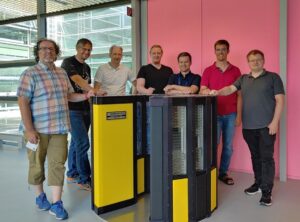
Source: Freepik
In the fast-paced world of high-performance computing (HPC), researchers and scientists are constantly seeking innovative solutions to enhance system performance and optimize resource utilization. One such endeavor is the targetDART project, a collaborative effort between the Technical University of Munich (TU Munich), the High-Performance Computing Center Stuttgart (HLRS), and several other academic, clinical, and industrial partners. With the aim of advancing dynamic task migration, targetDART is poised to push the boundaries of HPC capabilities.
Unleashing the Power of Dynamic Task Migration
The targetDART project addresses the challenge of efficiently migrating tasks between CPUs, GPUs, and nodes in real-time during application execution. By dynamically relocating tasks based on workload demands, system resources can be effectively utilized, resulting in improved performance and reduced execution times. This approach enables applications to harness the full potential of the underlying hardware architecture, achieving optimal efficiency.
Building on the Success of the Chameleon Project
The Chameleon project serves as a foundation for targetDART, providing valuable insights and results on dynamic task migration. Leveraging this knowledge, targetDART aims to develop a library and API for seamless task migration between nodes. This innovative capability will empower developers and researchers to efficiently utilize resources across a distributed computing environment, unleashing new possibilities for HPC applications.
Exploring the Power of OpenMP and MPI
To maximize the potential of GPUs, the targetDART project will utilize the OpenMP target construct, enabling the generation of tasks suitable for both CPUs and GPUs. By harnessing the parallel processing capabilities of GPUs, applications can achieve significant speedups and enhanced computational efficiency. Furthermore, the project will employ MPI, particularly the new 4.0 standard, to ensure efficient communication and coordination between nodes, facilitating seamless task migration across the system.
Real-World Applications and Collaborative Efforts
targetDART’s impact extends beyond theoretical advancements, as the project seeks to apply its innovative approach to real-world scenarios. SeisSol, a dynamic earthquake and seismic wave simulator, and ExaHyPE, a solver for hyperbolic partial differential equations, will serve as test cases for evaluating the effectiveness of dynamic task migration. By assessing the performance of these complex applications, the project aims to validate its approach and demonstrate tangible benefits for HPC practitioners.
Collaboration: Key to Success

f.l.t.r.: Jose Gracia (HLRS), Tobias Weinzerl (DUR), Michael Bader (TUM), Adrian Schmitz (RWTH), Christian Siebert (HLRS), David Schneller (TUM), Mario Wille (TUM)
Source: Own illustration
The targetDART project thrives on collaboration, combining the expertise of multiple institutions and partners. While RWTH Aachen University focuses on OpenMP, target constructs, and CPU-GPU migration, HLRS specializes in MPI and optimization of migration between nodes. TU Munich contributes its expertise in application optimization and focuses on advancing SeisSol and ExaHyPE. Through joint efforts and shared knowledge, TargetDART is poised to deliver groundbreaking advancements in the field of dynamic task migration.
The targetDART project represents a significant leap forward in the realm of dynamic task migration in high-performance computing. By leveraging the findings of the Chameleon project and harnessing the power of OpenMP, MPI, and collaborative efforts, targetDART aims to enable seamless task migration across CPUs, GPUs, and nodes. This will unlock new dimensions of performance and resource utilization, empowering researchers, and scientists to tackle complex problems more efficiently than ever before. As targetDART progresses, the HPC community eagerly anticipates the transformative advancements it will bring to the field. Current status updates can be found on the project website.
Responsible for the content of this article are Adrian Schmitz, Malak Mostafa und Janin Vreydal.




